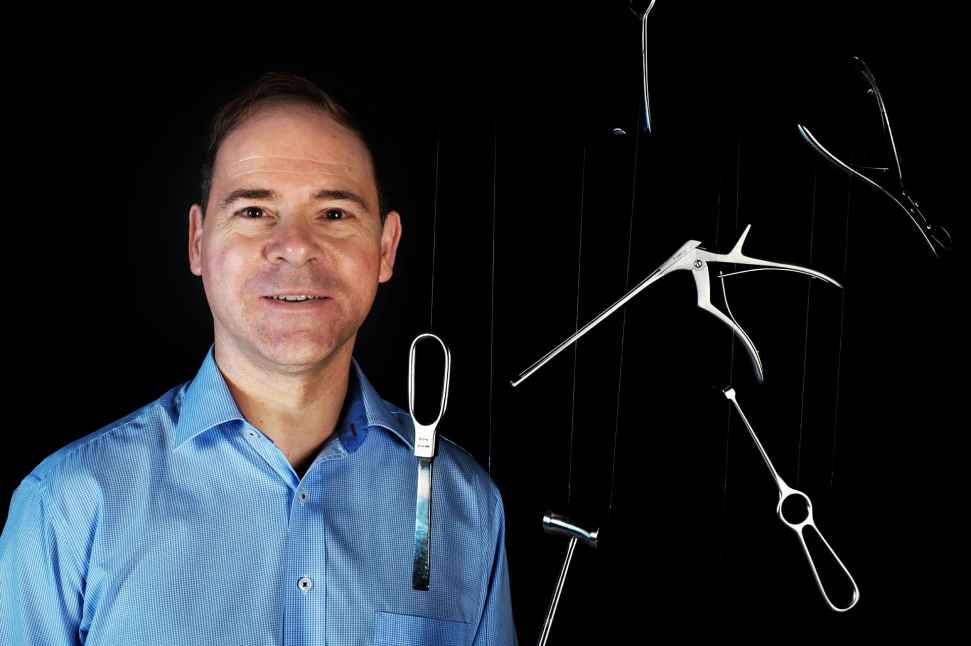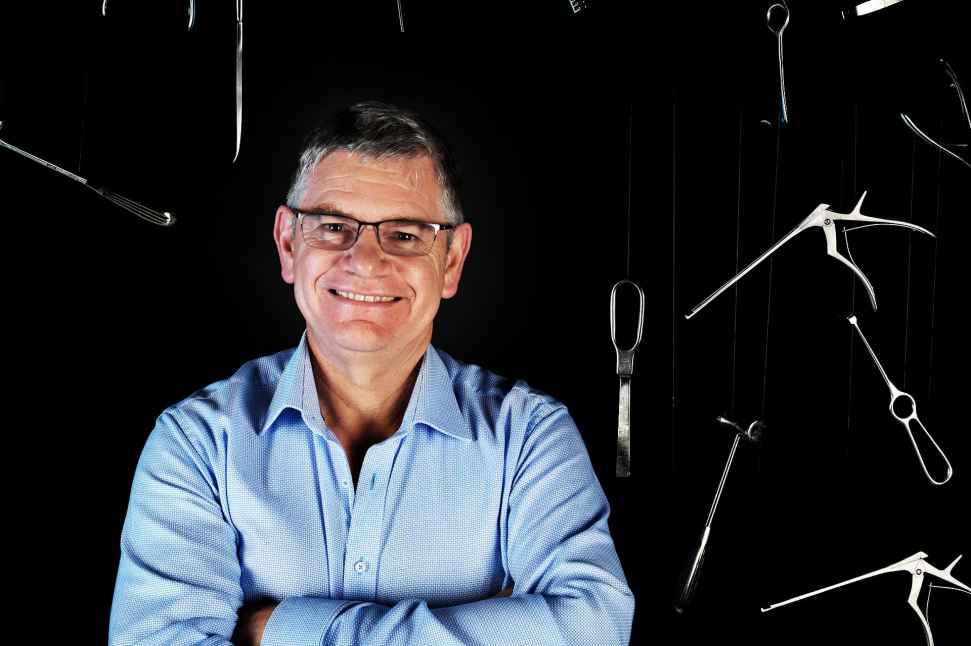Putting South Australia on the map for musculoskeletal research
Surgical skills for upper limbs
Internationally renowned upper limb orthopaedic surgeon Professor Greg Bain and biomechanical engineer Associate Professor John Costi are a collaborative dream team. They share a common goal: to improve the way we do upper limb surgeries and teach others to do the same.
Professor Greg Bain (L) and Associate Professor John Costi (R)
Professor Greg Bain and Associate Professor John Costi are leading the way when it comes to implants and the surgeries that come with them.
Their lab is a bright, open space overlooking the former Mitsubishi factory at Tonsley, with a panoramic view of the city and Adelaide hills. Trays of metal instruments (chisels, mallets, forceps, nibblers and pliers that were designed 50 years ago and remain the basic tools of surgery) sit alongside advanced imaging, arthroscopy, surgery and engineering equipment. Operating tables are pushed up against the walls, but it’s easy to imagine 30 focused surgeons taking up the space and learning alongside each other. It is clear why implant companies are flocking to the facility, asking Greg and John to help train surgeons in their newest technologies and surgical procedures. The modern facility would be the envy of any company and Greg and John are both leaders in their fields. The advanced courses they facilitate give practical, hands-on skills to surgeons. With access to Flinders’ groundbreaking Hexapod Robot, surgeons see firsthand the effect of their surgical techniques on the stability of the bone or joint. The data and knowledge that can be gathered in just a matter of hours is incredible, and the vision for the facility as a combination of surgical skills training with biomechanical testing will be an Australian first.
Step through into the adjoining room and you’re likely to stumble across an international, visiting surgeon or a PhD student working to understand the biomechanics of a new implant or surgical technique. For John and Greg, their ideas for new techniques and surgeries in the upper limb come from Greg’s first-hand experience with patients. If someone presents with a complex problem where the usual solutions don’t work, he brings his thoughts to John and together they develop new ways of doing things—with Greg bringing the surgical know-how and John testing their ideas on his biomedical engineering equipment. John will say ‘Actually that’s not realistic and we need to be focused’ or ‘These are the outcomes that I can deliver,’ and together they figure out which ideas have potential.
Our work is putting Adelaide on the map and making a real-world difference. It feels great.


The aim for us is to create new techniques that we can do safely and that actually do change the patient's quality of life.
Other projects are more theoretical. Greg—with the use of John’s lab—is currently dissecting the end of the radius bone to identify exactly where the ligaments and tendons are, and thus where an implanted plate should sit. It may seem strange, but there is still so much we don’t know about the human body—including how our wrists work. Greg and John both hold high standards for themselves in academia and in industry practice. Their research is always innovative, high quality, rigorous and scientific; they publish in high quality, peer reviewed journals and present at conferences around the world.
On the other side of the training space is an engineering hub that houses all manner of equipment, although the pride and joy is the Hexapod Robot. The unique robot sits in the centre of the room and allows users to reproduce the movements of joints in the body. The Hexapod is so precise it can test down to tiny 0.01 mm displacements. John controls it like a flight simulator, testing how joints and implants move. It’s hot commodity for companies wanting to test their implants; John is working with companies and researchers all over the world, from the USA to Sweden.
The dream for Greg and John is developing their own implants. They have the skills, the knowledge (both medicine and engineering), the ideas, the facilities and the state-of-the-art technology to design, create and test new concepts. They have relationships with Flinders Medical Centre to undertake clinical trials. It’s simply a matter of pulling it all together. ‘One day Flinders University at Tonsley really could become the hub of musculoskeletal research in Australasia,’ Greg suggests, sharing a look with John. They both see it as a place where great innovation occurs, where young engineers, bio-mechanics and clinicians train and work in collaboration—just like them.
Fast Facts
- The Flinders Surgical Lab is a state-of-the-art, 250 square metre, level 2 physical containment compliant (PC2) facility worth $2.1 million, facilitating an amazing collaboration of teaching, research and multidisciplinary work.
- The Surgical Lab can facilitate surgical training workshops for small or large groups of up to 40 people.
- The Surgical Lab is home to Flinders University’s Six Degree of Freedom Hexapod Robot, which provides accurate and realistic 3D loading of joints and implants under different loading conditions and movements—allowing the simulation of hundreds of complex movements.
- Flinders’ Hexapod Robot was awarded the 2012 Engineering Excellence South Australian Award for Innovation/Research and Development and also the highest accolade from Engineering Australia, the Malcolm Kinnaird Engineering Excellence Award. In 2016, the robot gained international recognition after receiving second-place in the National Instruments Engineering Impact Award (Industrial Machinery and Control category).
- The Surgical Lab is bringing medicine and engineering together to make a real difference for surgical outcomes.
- Development of the lab took four years. It involved extensive planning to create a world-class facility compliant with the state and national regulations.
Professor Greg Bain completed his orthopaedic surgery training in 1993 and been practising upper limb orthopaedic surgery in Adelaide ever since. He is a leading expert in the field, having edited the book Normal and Pathological Anatomy of the Shoulder and published many peer reviewed publications and book chapters. He is currently President of the Asia Pacific Wrist Association and has previously been the recipient of the Australian Orthopaedic Association Research Award for 'producing outstanding orthopaedic research that has international recognition and research contributing to the orthopaedic community and the community generally.' Professor Bain's research interests include clinical anatomy, biomechanics, advanced arthroscopic techniques, and anatomically based reconstructive procedures and arthroplasty.
Associate Professor John Costi completed his mechanical engineering degree in 1991 and was awarded his PhD in biomechanics of the intervertebral disc in 2004. He joined Flinders University as an academic and biomechanical engineer in 2009. Associate Professor Costi spent three years building his biomechanics research laboratory and program of research, and led a collaborative team to design and develop an award-winning six degree of freedom Hexapod Robot. In 2015, he was elected to the grade of Fellow of the Institution of Engineers Australia in both mechanical and biomedical engineering. Associate Professor Costi is Director of the Surgical Skills at Flinders lab, Director of Studies (Course Coordinator) for Mechanical Engineering at Flinders, and he leads both the Biomechanics and Implants Research Group and the Medical Device Research Institute at Flinders University. He also sits on the Board of Directors for the Spine Society of Australia.
Breath testing for a deadly cancer
Research that puts you to sleep (in a good way)
The avatar nurse improving heart health
![]()
Sturt Rd, Bedford Park
South Australia 5042
South Australia | Northern Territory
Global | Online


